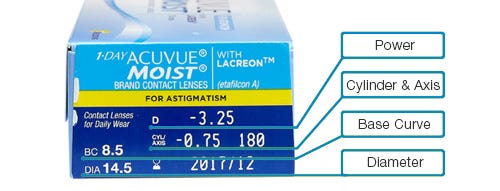Terms and ConditionsPrivacy Policy Consumer Rights
©Copyright 2024 by lens.me. All Rights Reserved.The meaning of a Contact Lens Prescription for Astigmatism
Astigmatism is one of the most common refractive errors in the Middle East
Many of our customers have an astigmatism but don't know the meaning of their prescription powers. Here is an explanation.
When looking at the contact lens box (here shown Acuvue Moist for Astigmatism as example), there are lots of numbers. But what do they mean?

What does each prescription figure mean?
Power/Sphere (PWR/SPH): This figure states whether you are long or short-sighted and how poor your vision is. If you are long-sighted your figure will begin with a + (plus sign) and if you are short-sighted it will begin with a – (minus sign), this will be followed by a number that goes up from 0 in measures of 0.25 diopters, the higher the number the stronger the visual correction needed (this value can be displayed on the box as "PWR" or "D" for Diopters).
Prescription Figures for Astigmatism
The below figures are only displayed on contact lens prescriptions where there is a need for astigmatism correction.
Cylinder (CYL): The cylinder will ALWAYS be a minus (-) number that increases in measures of 0.25. Much like the power/sphere figure that is shown on all standard prescriptions, the cylinder denotes the extra visual requirements needed for astigmatism and how severe the astigmatism is.
Axis (AX): Astigmatism is caused by the irregular curvature of the eye; the axis is a figure which determines the angle of the correction needed in order to see clearly. The Axis is always a number between 0 and 180 degrees.
The following measurements Base curve and Diameter are related to the form and fit of the contact lens but not to the refractive correction.
Base Curve (BC):The base curve determines what type of fit is required for the lens to meet the curve of your eye; this is usually written in millimetres
Diameter (DIA): As you’ve probably guessed it’s the diameter of the contact lens also written in millimetres like the base curve, it tells the optician which width of lens best fits your eye.



